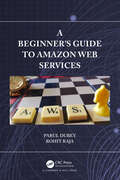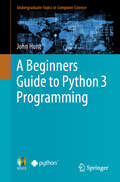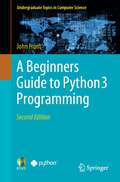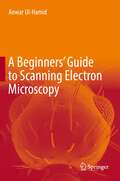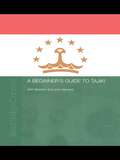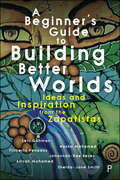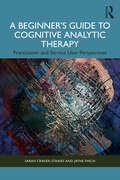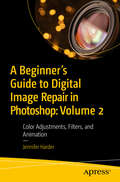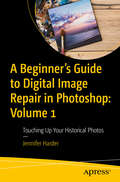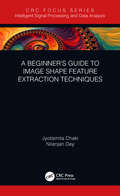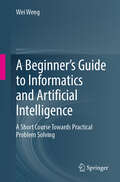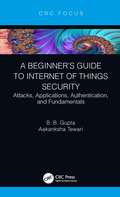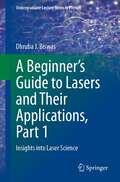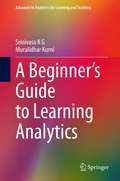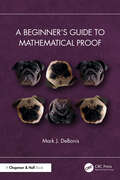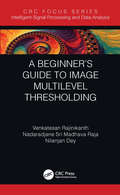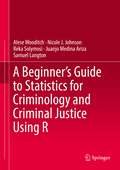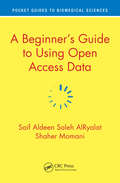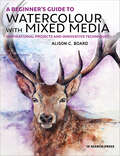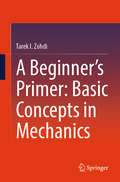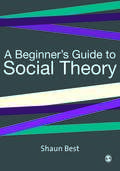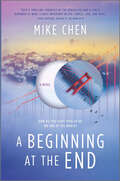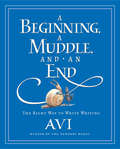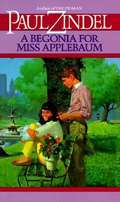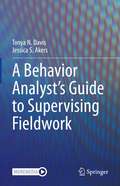- Table View
- List View
A Beginners Guide to Amazon Web Services
by Rohit Raja Parul DubeyAmazon Web Services (AWS) provides on-demand cloud computing platforms and application programming interfaces (APIs) to individuals, companies, and govern- ments, along with distributed computing processing capacity and software tools via AWS server farms. This text presents a hands-on approach for beginners to get started with Amazon Web Services (AWS) in a simple way. Key Features It discusses topics such as Amazon Elastic Compute Cloud, Elastic Load Balancing, Auto Scaling Groups, and Amazon Simple Storage Service. It showcases Amazon Web Services’ identity, access management resources, and attribute-based access control. It covers serverless computing services, Virtual Private Cloud, Amazon Aurora, and Amazon Comprehend. It explains Amazon Web Services Free Tier, Amazon Web Services Marketplace, and Amazon Elastic Container Service. It includes security in Amazon Web Services, the shared responsibilitymodel, and high-performance computing on Amazon Web Services. The text is primarily written for graduate students, professionals, and academic researchers working in the fields of computer science, engineering, and information technology. Parul Dubey is currently working as an Assistant professor in the Department of Artificial Intelligence at G H Raisoni College of Engineering, Nagpur, India. She has filed for 15 Indian patents. She is responsible for about 10 publications in conference proceedings, Scopus, and journals. She has contributed book chapters in an edited book published by CRC Press and other reputed publishers. She is also an AWS Certified Cloud Practitioner. Rohit Raja is working as an associate professor and head in the Department of Information Technology at Guru Ghasidas Vishwavidyalaya, Bilaspur, India. His research interests include facial recognition, signal processing, networking, and data mining. He has pub- lished 100 research papers in various international and national journals (including publications by the IEEE, Springer, etc.) and proceedings of reputed international and national conferences (again including publications by Springer and the IEEE).
A Beginners Guide to Python 3 Programming (Undergraduate Topics in Computer Science)
by John HuntThis textbook on Python 3 explains concepts such as variables and what they represent, how data is held in memory, how a for loop works and what a string is. It also introduces key concepts such as functions, modules and packages as well as object orientation and functional programming. Each section is prefaced with an introductory chapter, before continuing with how these ideas work in Python. Topics such as generators and coroutines are often misunderstood and these are explained in detail, whilst topics such as Referential Transparency, multiple inheritance and exception handling are presented using examples. A Beginners Guide to Python 3 Programming provides all you need to know about Python, with numerous examples provided throughout including several larger worked case studies illustrating the ideas presented in the previous chapters.
A Beginners Guide to Python 3 Programming (Undergraduate Topics in Computer Science)
by John HuntThis textbook is aimed at readers who have little or no knowledge of computer programming but want to learn to program in Python. It starts from the very basics including how to install your Python environment, how to write a very simple program and run it, what a variable is, what an if statement is, how iteration works using for and while loops as well as important key concepts such as functions, classes and modules. Each subject area is prefaced with an introductory chapter, before continuing with how these ideas work in Python. The second edition has been completely updated for the latest versions of Python including Python 3.11 and Python 3.12. New chapters have been added such as those that consider where and how Python is used, the use of Frozensets, how data can be sorted, enumerated types in Python, structural pattern matching and how (and why) Python Virtual Environments are configured. A new chapter ‘The Python Bites back’ is introduced to present the fourteen most common / biggest gotchas for someone new to Python. Other sections have been updated with new features such as Exception Groups, string operations and dictionary operations. A Beginners Guide to Python 3 Programming second Edition provides all you need to know about Python, with numerous examples provided throughout including several larger worked case studies illustrating the ideas presented in the previous chapters.
A Beginners' Guide to Scanning Electron Microscopy
by Anwar Ul-HamidThis book was developed with the goal of providing an easily understood text for those users of the scanning electron microscope (SEM) who have little or no background in the area. The SEM is routinely used to study the surface structure and chemistry of a wide range of biological and synthetic materials at the micrometer to nanometer scale. Ease-of-use, typically facile sample preparation, and straightforward image interpretation, combined with high resolution, high depth of field, and the ability to undertake microchemical and crystallographic analysis, has made scanning electron microscopy one of the most powerful and versatile techniques for characterization today. Indeed, the SEM is a vital tool for the characterization of nanostructured materials and the development of nanotechnology. However, its wide use by professionals with diverse technical backgrounds—including life science, materials science, engineering, forensics, mineralogy, etc., and in various sectors of government, industry, and academia—emphasizes the need for an introductory text providing the basics of effective SEM imaging.A Beginners’ Guide to Scanning Electron Microscopy explains instrumentation, operation, image interpretation and sample preparation in a wide ranging yet succinct and practical text, treating the essential theory of specimen-beam interaction and image formation in a manner that can be effortlessly comprehended by the novice SEM user. This book provides a concise and accessible introduction to the essentials of SEMincludes a large number of illustrations specifically chosen to aid readers' understanding of key conceptshighlights recent advances in instrumentation, imaging and sample preparation techniquesoffers examples drawn from a variety of applications that appeal to professionals from diverse backgrounds.
A Beginners' Guide to Tajiki
by Azim Baizoyev John HaywardThis is a conversational approach to the teaching and learning of the Tajiki language. It uses authentic language material to help learners as they proceed through its topic-based lessons. Its emphasis on the spoken language promotes oral fluency alongside written skills. Both lessons and appendices present new vocabulary and grammar simply and recycle material to provide opportunities for both controlled and free language learning.The appendices include not only lists of useful information and samples of commonly needed letters and speeches but also an invaluable introduction to Tajiki grammar and a comprehensive Tajiki-English dictionary of all the book's vocabulary - over 4500 definitions.
A Beginner’s Guide to Building Better Worlds: Ideas and Inspiration from the Zapatistas
by Levi Gahman Nasha MohamedThis ambitious book offers radical alternatives to conventional ways of thinking about the planet’s most pressing challenges, ranging from alienation and exploitation to state violence and environmental injustice. Bridging real-world examples of resistance and mutual aid in Zapatista territory with big-picture concepts like critical consciousness, social reproduction and decolonisation, the authors encourage readers to view themselves as co-creators of the societies they are a part of – and ‘be Zapatistas wherever they are'. Written by a diverse team of first-generation authors, this book offers an emancipatory set of anti-colonial ideas related to both refusing liberal bystanding and collectively constructing better worlds and realities.
A Beginner’s Guide to Cognitive Analytic Therapy: Practitioner and Service User Perspectives
by Sarah Craven-Staines Jayne FinchThis text provides an accessible, reader-friendly guide to conducting Cognitive Analytic Therapy (CAT) on a one-to-one basis, developed in partnership with service users who have lived experience of CAT.The book will cover the applications of CAT in clinical practice including: assessment; introducing CAT; the main concepts and how to build a therapeutic relationship; mapping; the middle phase and the integration of other models; monitoring; developing exits; the ending and saying goodbye. Grounded in CAT theory, the content will be ordered sequentially, as one would conduct the therapy, and will feature first-hand accounts from CAT-experienced service users including their own perspectives on the model and the impact it had on their wellbeing.A straightforward, beginner’s introduction to practicing CAT, this book will be useful for trainee practitioners, assistant and trainee clinical/counselling psychologists, and those practising CAT-informed therapy in supervision.
A Beginner’s Guide to Digital Image Repair in Photoshop: Color Adjustments, Filters, and Animation
by Jennifer HarderContinue to explore how to digitally restore your old historical photos in Photoshop for print out or to use online as still photos. As you progress through this volume’s chapters, you’ll look at some of the many color adjustments and filters that Photoshop has to offer, both old and new. These can assist you in your restoration project or to animate select images. A Beginner’s Guide to Digital Image Repair in Photoshop: Volume 2 shares various techniques and tips that you can use to restore your own photos using Photoshop’s Adjustment Layers and filters. You’ll look at some basic animation options and the various techniques you can use in Photoshop to repair damage. When done you’ll be ready to move beyond Photoshop and explore the next steps in your project. What You’ll Learn Use the new and improved Adjustment Layers panel for basic overall color correction. Discover which old and new filters are useful for repairing most photo issues. Animate photos using the Photoshop Timeline panel. Who Is This Book For Beginning to Intermediate-level users who would like to learn how to repair old historical photos and slides for digital presentation or for print. Also, for those who are interested in basic digital image repair and animation.
A Beginner’s Guide to Digital Image Repair in Photoshop: Touching Up Your Historical Photos
by Jennifer HarderDigitally restore your old photos in Photoshop for print out or to use online as still photos. This first of two volumes will show you some of the basic techniques you can use in Photoshop to preserve or repair damaged family and historical photos. In today’s digital world of smart phones and cameras, you can easily transfer your photos from phone to computer. However, occasionally you’re left with an old or damaged version of the image and the uncertainty of how to fix them. Aided by the sound advice and tips from author Jennifer Harder, this book will show you how to do so with just a few basic corrections in Photoshop. Using healing tools, basic color correction tools, layer masks, and workspace commands to fill in missing gaps, you’ll be able to print out an unblemished picture or post it on your social media page. A Beginner’s Guide to Digital Image Repair in Photoshop: Volume 1 provides the know-how to help preserve your family treasures. What You Will Learn Review scanner basics for digitizing your photos Use various “healing” and color adjustment tools in Photoshop for restoring photos See how custom selections and layer masks can be used in the photo restoration process Apply various workspaces to fill in missing details in an image or merge photos Who Is This Book For Users who want to learn how to repair old historical photos and slides for digital presentation or for print as well as those who are interested in basic animation.
A Beginner’s Guide to Image Shape Feature Extraction Techniques (Intelligent Signal Processing and Data Analysis)
by Nilanjan Dey Jyotismita ChakiThis book emphasizes various image shape feature extraction methods which are necessary for image shape recognition and classification. Focussing on a shape feature extraction technique used in content-based image retrieval (CBIR), it explains different applications of image shape features in the field of content-based image retrieval. Showcasing useful applications and illustrating examples in many interdisciplinary fields, the present book is aimed at researchers and graduate students in electrical engineering, data science, computer science, medicine, and machine learning including medical physics and information technology.
A Beginner’s Guide to Informatics and Artificial Intelligence: A Short Course Towards Practical Problem Solving
by Wei WengEmbark on a transformative learning journey with this book, a concise and engaging short course for those taking their first steps into the realms of information science and AI. Ideal for undergraduates, graduates, and professionals, this book lays a sturdy foundation upon which readers can build whether their aim is to undertake research projects, pursue a career in technology, or simply understand the workings of the digital age.The learning objectives are:* Foundational understanding: Build a sturdy foundation by introducing basic concepts and gradually progressing to advanced topics.* Practical problem-solving: Foster the ability to solve real-world problems through guided exercises and application-oriented learning.* Holistic knowledge: Provide a holistic understanding of information science and AI, empowering learners to contribute meaningfully to the future of these disciplines.The key features are:* Comprehensive coverage: Explore computer science basics to advanced AI techniques for a holistic understanding of the field.* Engaging writing style: Complex concepts made approachable for beginners without sacrificing depth.* Bridging theory with application: Real-world scenarios illustrate and encourage practical applications.* Practical exercises: Guided hands-on exercises develop problem-solving skills, ensuring a practical understanding of the material.* Enriched learning experience: Vivid examples, flowcharts, and interactive elements bring concepts to life. E-lectures of the book "Informatics and Artificial Intelligence for Beginners I & II" will be released on Springer Video soon to further enhance the learning experience.
A Beginner’s Guide to Internet of Things Security: Attacks, Applications, Authentication, and Fundamentals
by B. B. Gupta Aakanksha TewariA Beginner’s Guide to Internet of Things Security focuses on security issues and developments in the Internet of Things (IoT) environment. The wide-ranging applications of IoT, including home appliances, transportation, logistics, healthcare, and smart cities, necessitate security applications that can be applied to every domain with minimal cost. IoT contains three layers: application layer, middleware layer, and perception layer. The security problems of each layer are analyzed separately to identify solutions, along with the integration and scalability issues with the cross-layer architecture of IoT. The book discusses the state-of-the-art authentication-based security schemes, which can secure radio frequency identification (RFID) tags, along with some security models that are used to verify whether an authentication scheme is secure against any potential security risks. It also looks at existing authentication schemes and security models with their strengths and weaknesses. The book uses statistical and analytical data and explains its impact on the IoT field, as well as an extensive literature survey focusing on trust and privacy problems. The open challenges and future research direction discussed in this book will help to further academic researchers and industry professionals in the domain of security. Dr. Brij B. Gupta is an assistant professor in the Department of Computer Engineering, National Institute of Technology, Kurukshetra, India. Ms. Aakanksha Tewari is a PhD Scholar in the Department of Computer Engineering, National Institute of Technology, Kurukshetra, India.
A Beginner’s Guide to Lasers and Their Applications, Part 1: Insights into Laser Science (Undergraduate Lecture Notes in Physics)
by Dhruba J. BiswasThis two-volume book provides an enriching insight into the laser, covering different types of lasers, the basic science behind the technology, their role at the cutting-edge of current scientific research, and their wide-ranging applications. With just high school physics as a prerequisite and favoring qualitative yet scientifically sound explanations over high-level mathematics, this book is aimed at a broad spectrum of readers in physics, chemistry, engineering, medicine, and biology. Its engaging and lucid presentation is enhanced with plenty of illustrations, making the world of the laser accessible to undergraduate students in the sciences and any other inquisitive readers with high school physics under their belts. Furthermore, the text is often laced with anecdotes, picked from history, that are bound to pique the minds of the readers. It is ideal for self-study or as a complement to courses on optics and optoelectronics. This volume, Part 1 of 2, explains the fundamentals of optics, what a laser is, how it works, and what is unique about the light it emits, from fundamental quantum theory through population inversion and cavity to common laser types. It is followed by Part 2 which depicts the many advances in science enabled by the laser, including spectroscopy, nonlinear optics, optical cooling and trapping, and optical tweezers, among many others, and provides a glimpse into the ways that the laser affects our lives via its uses in medicine, manufacturing, the nuclear industry, energy, defence, communication, ranging, pollution monitoring, art conservation, fashion, beauty, and entertainment.
A Beginner’s Guide to Learning Analytics (Advances in Analytics for Learning and Teaching)
by Srinivasa K G Muralidhar KurniThis book A Beginner’s Guide to Learning Analytics is designed to meet modern educational trends’ needs. It is addressed to readers who have no prior knowledge of learning analytics and functions as an introductory text to learning analytics for those who want to do more with evaluation/assessment in their organizations. The book is useful to all who need to evaluate their learning and teaching strategies. It aims to bring greater efficiency and deeper engagement to individual students, learning communities, and educators.Covered here are the key concepts linked to learning analytics for researchers and practitioners interested in learning analytics. This book helps those who want to apply analytics to learning and development programs and helps educational institutions to identify learners who require support and provide a more personalized learning experience. Like chapters show diverse uses of learning analytics to enhance student and faculty performance. It presents a coherent framework for the effective translation of learning analytics research for educational practice to its practical application in different educational domains. This book provides educators and researchers with the tools and frameworks to effectively make sense of and use data and analytics in their everyday practice. This book will be a valuable addition to researchers’ bookshelves.
A Beginner’s Guide to Mathematical Proof
by Mark J. DeBonisA Beginner’s Guide to Mathematical Proof prepares mathematics majors for the transition to abstract mathematics, as well as introducing a wider readership of quantitative science students, such as engineers, to the mathematical structures underlying more applied topics. The text is designed to be easily utilized by both instructor and student, with an accessible, step-by-step approach requiring minimal mathematical prerequisites. The book builds towards more complex ideas as it progresses but never makes assumptions of the reader beyond the material already covered.Features No mathematical prerequisites beyond high school mathematics Suitable for an Introduction to Proofs course for mathematics majors and other students of quantitative sciences, such as engineering Replete with exercises and examples
A Beginner’s Guide to Multilevel Image Thresholding (Intelligent Signal Processing and Data Analysis)
by Nilanjan Dey Venkatesan Rajinikanth Nadaradjane Sri Madhava RajaA Beginner’s Guide to Image Multi-Level Thresholding emphasizes various image thresholding methods that are necessary for image pre-processing and initial level enhancement. Explains basic concepts and the implementation of Image Multi-Level Thresholding (grayscale and RGB images) Presents a detailed evaluation in real-time application, including the need for heuristic algorithm, the choice of objective and threshold function, and the evaluation of the outcome Describes how the image thresholding acts as a pre-processing technique and how the region of interest in a medical image is enhanced with thresholding Illustrates integration of the thresholding technique with bio-inspired algorithms Includes current findings and future directions of image multi-level thresholding and its practical implementation Emphasizes the need for multi-level thresholding with suitable examples The book is aimed at graduate students and researchers in image processing, electronics engineering, computer sciences and engineering.
A Beginner’s Guide to Statistics for Criminology and Criminal Justice Using R
by Alese Wooditch Nicole J. Johnson Reka Solymosi Juanjo Medina Ariza Samuel LangtonThis book provides hands-on guidance for researchers and practitioners in criminal justice and criminology to perform statistical analyses and data visualization in the free and open-source software R. It offers a step-by-step guide for beginners to become familiar with the RStudio platform and tidyverse set of packages. This volume will help users master the fundamentals of the R programming language, providing tutorials in each chapter that lay out research questions and hypotheses centering around a real criminal justice dataset, such as data from the National Survey on Drug Use and Health, National Crime Victimization Survey, Youth Risk Behavior Surveillance System, The Monitoring the Future Study, and The National Youth Survey. Users will also learn how to manipulate common sources of agency data, such as calls-for-service (CFS) data. The end of each chapter includes exercises that reinforce the R tutorial examples, designed to help master the software as well as to provide practice on statistical concepts, data analysis, and interpretation of results. The text can be used as a stand-alone guide to learning R or it can be used as a companion guide to an introductory statistics textbook, such as Basic Statistics in Criminal Justice (2020).
A Beginner’s Guide to Using Open Access Data (Pocket Guides to Biomedical Sciences)
by Saif Aldeen AlRyalat Shaher MomaniOpen Access Data is emerging as a source for cutting edge scholarship. This concise book provides guidance from generating a research idea to publishing results. Both young researchers and well-established scholars can use this book to upgrade their skills with respect to emerging data sources, analysis, and even post-publishing promotion. At the end of each chapter, a tutorial simulates a real example, allowing readers to apply what they learned about accessing open data, and analyzing this data to reach the results. This book can be of use by established researchers analyzing data, publishing, and actively promoting ongoing and research. Key selling features: Describes the steps, from A-Z, for doing open data research Includes interactive tutorials following each chapter Provides guidelines for readers so that they can use their own accessed open data Reviews recent software and websites promoting and enabling open data research Supplements websites which update recent open data sources
A Beginner’s Guide to Watercolour with Mixed Media: Inspirational Projects and Innovative Techniques
by Alison C. BoardAdding other mediums to your watercolour paintings is a fantastic way to take your work in new, more exciting directions. However, the vast array of painting mediums and materials on the market can be daunting, especially for the beginner. This book introduces the reader to the range of media that is available, explains briefly and clearly how to use the materials and provides six step-by-step projects and inspirational finished paintings to encourage you to take a definitive leap into the exciting world of mixed media art.Author Alison C Board covers a multitude of topics in her work, and this book features flowers, animal portraits, dancers in motion, cityscapes and landscapes. She explores how to combine wet and dry media, and how to create vibrant collages from man-made and natural found objects.There are no mistakes in mixed-media artwork, and Alison encourages the reader to be unafraid and embrace the experimental.
A Beginner’s Primer: Basic Concepts in Mechanics
by Tarek I. ZohdiAs we enter an exciting new era in industrial design, simulation, and manufacturing, a clear understanding of mechanics of solids is needed now more than ever. This primer is a condensed synopsis of basic undergraduate mechanics and is designed to supplement classical textbooks in this area. The focus is on the essentials of mechanics, specifically: • The concept of stress. • Stress-strain relationships. • Failure theory. • Axial loading of a rod. • Transverse (bending) loading of a beam. • Industrial application: modeling of 3D printing. • Transverse shear stresses. • Torsional loading of a rod. • Pressure vessels. • Buckling of columns. • The basics of finite element methods. • A unifying concept: continuum mechanics.
A Beginner′s Guide to Social Theory
by Shaun Best`This book is accessible, as a beginner′s guide should be, but without an over-simplification of the arguments. It should prove an immensely durable text for generations of students to come′ - John Hughes, Lancaster University At last, a book that makes social theory for undergraduates a pleasure to teach and study. The book offers a comprehensive overview of social theory from classical sociology to the present day. Students are guided through the work of Durkheim, Marx and Weber, functionalism, action perspectives, feminism, postmodernism and contemporary thinkers like Anthony Giddens, Michel Foucault, J[um]urgen Habermas, Frederic Jameson, Judith Butler, Gilles Deluze, Manuel Castells, Luce Irigary, Naomi Woolf and Camille Paglia. The book presents clear accounts of these contributions and employs an extensive range of activities that encourage the reader to evaluate the work of given theorists and approaches. The book is: - Comprehensive - Student-friendly - Accurate - Unpatronising It offers lecturers and students an ideal study resource for undergraduate modules in social theory.
A Beginning at the End: A Novel
by Mike ChenFour survivors unite in the aftermath of a global pandemic as the nation rebuilds in this character-driven postapocalyptic tale of family, love, and hope.From the New York Times–bestselling author of Star Wars: BrotherhoodSix years after a virus wiped out most of the planet’s population, former pop star Moira is living under a new identity to escape her past—until her domineering father launches a sweeping public search to track her down. Desperate for a fresh start herself, jaded event planner Krista navigates the world for those still too traumatized to go outside, but she never reaches out on her own behalf. Rob has tried to protect his daughter, Sunny, by keeping a heartbreaking secret, but when strict government rules threaten to separate parent and child, Rob needs to prove himself worthy in the city’s eyes by connecting with people again.Krista, Moira, Rob and Sunny meet by circumstance and their lives begin to twine together. When reports of another outbreak throw the fragile society into panic, the friends are forced to finally face everything that came before—and everything they still stand to lose. Because sometimes having one person is enough to keep the world going.“This postapocalyptic slice-of-life novel from Chen delivers big emotions by keeping the focus small. . . . By foregrounding family, Chen manages to imbue his apocalypse with heart, hope, and humanity. Sci-fi fans will delight in this lovingly rendered tale.” —Publishers Weekly (starred review, PW Picks)“Sometimes it is not the violent battles of post-apocalyptic stories that pull readers in; it is the emotional connection of humanity finding their way. Chen’s prose lights a brilliant, fragile path through the darkness.” —Library Journal (starred review)“The best kind of dystopian novel: one rooted deeply in the hearts of his characters and emphasizing hope and connection over fear. Chen has a true gift for making the biggest of worlds center around the most complex workings of hearts, and his newest is compelling, realistic, and impossible to put down.” —Booklist (starred review)
A Beginning, a Muddle, and an End: The Right Way to Write Writing
by Avi Tricia TusaAvon the snail and Edward the ant are back for another funny--and philosophical--adventure. This time, Avon has decided he wants to be a writer, only to discover that writing is way more difficult than he ever imagined. He finally gets the word Something written down, but there's a problem: What to write next? Luckily, his friend Edward is there to advise. Brimming with wit, wisdom, and humor, this warm and winning tale of two friends on a quest will be enjoyed by readers (and writers) of all ages.
A Begonia for Miss Applebaum
by Paul ZindelWhen Henry and Zelda become the Saturday companions of their, beloved teacher, her exuberance for learning, having fun, and helping the homeless is contagious. Their visits to Central Park, museums, and other places around New York City open an exciting new world to Zelda and Henry. But Miss Applebaum can't escape the inevitable. Will Henry and Zelda be able to carry out her last wish?
A Behavior Analyst’s Guide to Supervising Fieldwork
by Tonya N. Davis Jessica S. AkersThis guide is specifically designed for supervisors of trainees completing fieldwork requirements for the Board-Certified Behavior Analyst (BCBA) credential, to ensure a well-planned and well-documented fieldwork experience. Supervisors have a significant responsibility to plan, sequence, implement, and track their supervisee's fieldwork and skill acquisition. This guide was created to align with the Board-Certified Behavior Analyst Task List, providing a structured curriculum to support the many responsibilities of a supervisor, and covering a wide range of topics. The book includes instructions for group and individual supervision activities, homework activities for supervisees, and methods of assessing skills. It is designed to support the supervisor by covering all aspects key to supervision. Its many additional materials are designed to maximize the supervisor's use of time, and to gauge the effectiveness of their work. It is evidence-based and practically oriented, and will benefit the supervisor as well as the trainee.
